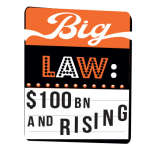What we do not know about the surreal period we’re in thanks to the coronavirus pandemic would fill the proverbial book for law firm leaders, or actually several. I won’t presume to speak to medical/scientific issues, desperate as we are to have some clarity; I’m sticking with the economic/business/strategic issues.
What we don’t know, or don’t know with any degree of confidence, are:
• When we can prudently begin to restart the parts of the economy that are shut down;
• How to stage/phase it regionally or by metro area;
• How to stage/phase it by industry sector;
• Even if it’s all green-lighted from a regulatory and public health perspective, when will people’s confidence to venture forth and be among others in groups return?
• Which sectors will take the longest to recover from the anxiety hangover? Will we be able to simply walk down the street without tremendous self-consciousness of others’ distance? How ‘safe?’ will a typical office feel? Schools? Retail stores? Bars and restaurants? Theatres, museums, performing arts? Public transport?
• Will the return of confidence require a vaccine or would an effective (minimally, life-preserving) course of therapy be enough?
• And…you get the picture.
But that’s not what we’re discussing today.
It’s not that we know nothing about how or when this will end or what the post-Corona world will look like. Let’s examine a few more or less known knowns.
Real estate and office space
The office is dead, long live the office. The last great barrier to remote working from home – the psychological resistance premised on nothing other than, it turns out, habit and lack of imagination as to how it could possibly be different – has now fallen.
Even the most stubborn opponents of remote and virtual working are now converts. Meanwhile, admit it, you’ve discovered a new pastime: critiquing colleagues’ Zoom backgrounds: a bookcase? Can we identify any of the books by their spines? Let’s not even get started on wallpapers and upholstery.
Seriously, why did we need those tens of thousands of square feet of Class A space? We didn’t and we don’t.
I’m a dyed-in-the-wool fan of world-class global metropolises and they are under zero existential threat. Human beings are among the most social of all species, and among many of us the yearning for connecting again is palpable but we’ve learned it does not need to be five days a week with everyone at the centre of our work orbit.
Dense cities obviously have virtues – far more efficient use of resources, assets, and time, and frequent serendipitous physical interactions – but they also have costs, including the requirements of coordination, greater reliance on centralised systems, and congestion. The challenging-to-do but obvious-to-recognise intersection has to combine technology with the right public/private incentives to invest in truly, 21st-Century infrastructure.
What a once-a-century opportunity!
For those of you with leases coming due in the next few years, start talking to your architects now. The ‘other side’ office better not be a clone of today’s @ 25% scale; it needs to be designed clean-sheet-of-paper fresh to serve the functions offices will still be used for. My hunch is almost all (a) conference rooms; and (b) shared working spaces of all sizes, modular, flexible, and rapidly reconfigurable.
How you work
A few weeks ago I started seeing an article once a day or so showcasing a company that had done something creative and responsive to the crisis in record time. Everything from Zegna and LVMH reconfiguring the machinery they could to churn out PPE gowns instead of runway-wear to athletic helmet manufacturers pivoting to face masks and diving-helmet like scuba-gear for first-line medical workers to Ford and GM and Tesla realising they could mass-produce ventilators.
Now, instead of one or so articles a day, I must see half a dozen or more. But the defining feature of the latest innovation revolution is breakneck speed. Companies are being forced to raise their corporate metabolism and overcome ‘analysis paralysis’, an affliction caused by top managers having pored over the same irrelevant case studies at business school. In a recent briefing, consultants at Bain urged companies to throw out old data, test quickly and often, and assume you will be in testing mode for some time to come.
Elsewhere, you see that this crisis has dynamited organisational silos, hopefully for good. Collaboration is no longer honoured in the breach; it is lived, because suddenly people’s mere preferences in their comfort zone, insecurities, and neuroses, fall aside in the face of the imperative to get work done.
What might some of this experimentation look like in Law Land? In essence: let a thousand flowers bloom. Welcome suggestions from anyone. Try anything and everything that passes the laugh test and test quickly and often. Just as an example, if your firm’s internal teams are now meeting via Zoom or WebEx, how much more work would it be to invite the client, or a pricing specialist from your firm, or your head of e-discovery?
Start preparing for what will be hot and what not
Some practice areas will be sure-fire beneficiaries of this on the other side, and others probably will not be.
• Insolvency, restructuring, distressed assets: UP.
• Private equity: UP. According to State Street, in the 20 years since the turn of this century, the equity market has doubled in size, but the private equity market has expanded six-fold. Private equity investors have dry powder and all of a sudden a lot of potential targets have appeared if only because they’re so much cheaper than ten weeks ago.
• Regulatory investigations and dispute resolution a/k/a litigation: UP. Busted or cancelled deals, contract defaults, unpaid anything and everything, and a vast new frontier in exploring just what all those boilerplate orphans, the force majeure clauses, were actually supposed to mean.
• M&A and, maybe, antitrust: UP. From banking to retail to transport and logistics to the healthcare sector, big looks to benefit from this crisis while small is under tremendous strain. Look for companies seeking scale. Deal work may be something of medium-term payoff, given the deep freeze in general transactional activity in the current quarter, but a great deal of corporate reshaping via takeovers, restructurings and disposals is coming soon and will settle in for years to come.
• Tech and all the ancillary practices it spawns, including IP: UP. Suddenly tech in almost all its forms is not a toy or a merely nice-to-have, it’s the new operating system of all of our firms and most of our clients. Zoom, the poster child for this, has seen five years’ worth of growth compressed into six weeks.
We will also have some thoughts on one thing that is not going to do well now or into the future, and that’s weak, indecisive leadership. Law firm leaders must ultimately remember while plotting a course in these extraordinarily unpredictable times to start with what they know or can at least reasonably extrapolate. Because the journey never stops, however choppy the water.
Bruce MacEwen is the president of Adam Smith, Esq, a strategic consulting business focused on the legal industry. You can read his articles here.













